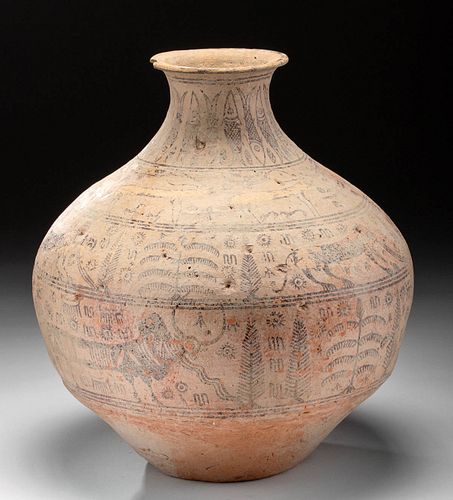Large Indus Valley Bichrome Jar w/ Animal Motif
Lot 58
About Seller
Artemis Fine Arts
686 S Taylor Ave, Ste 106
Louisville, CO 80027
United States
Selling antiquities, ancient and ethnographic art online since 1993, Artemis Gallery specializes in Classical Antiquities (Egyptian, Greek, Roman, Near Eastern), Asian, Pre-Columbian, African / Tribal / Oceanographic art. Our extensive inventory includes pottery, stone, metal, wood, glass and textil...Read more
Categories
Estimate:
$6,000 - $9,000
Absentee vs Live bid
Two ways to bid:
- Leave a max absentee bid and the platform will bid on your behalf up to your maximum bid during the live auction.
- Bid live during the auction and your bids will be submitted real-time to the auctioneer.
Bid Increments
| Price | Bid Increment |
|---|---|
| $0 | $25 |
| $300 | $50 |
| $1,000 | $100 |
| $2,000 | $250 |
| $5,000 | $500 |
| $10,000 | $1,000 |
| $20,000 | $2,500 |
| $50,000 | $5,000 |
| $100,000 | $10,000 |
| $200,000 | $20,000 |
About Auction
By Artemis Fine Arts
Oct 8, 2020
Set Reminder
2020-10-08 10:00:00
2020-10-08 10:00:00
America/New_York
Bidsquare
Bidsquare : Exceptional Antiquities, Asian, Ethnographic
https://www.bidsquare.com/auctions/artemis-gallery/exceptional-antiquities-asian-ethnographic-5796
Museum-worthy examples of Egyptian, Greek, Roman, Etruscan, Near Eastern, Far East / Asian, Pre-Columbian, African / Tribal,Oceanic, Native American, Spanish Colonial, Russian, Fossils, Ancient Jewelry, Fine Art, so much more! Artemis Fine Arts info@artemisfinearts.com
Museum-worthy examples of Egyptian, Greek, Roman, Etruscan, Near Eastern, Far East / Asian, Pre-Columbian, African / Tribal,Oceanic, Native American, Spanish Colonial, Russian, Fossils, Ancient Jewelry, Fine Art, so much more! Artemis Fine Arts info@artemisfinearts.com
- Lot Description
Central Asia, Indus Valley civilization, Pakistan (Baluchistan) Mehrgarh style, ca. 3000 to 2500 BCE. A beautiful ceramic vessel on a circular base with impressively thin walls that expand outwards forming a large bulbous body that tapers at the top to a thin neck and an extended flared rim coated in a thin line of brown paint. A lovely shade of light terracotta, this ancient jar is adorned with four intricately painted registers with imagery delineated in a mahogany hue that are divided by parallel linear striations, the second of which incised. From top to bottom, the registers feature: a pattern of long fish with criss-crossed scales, pointed heads, and target shaped eyes facing alternating directions of up and down, a repeated motif of grazing ibexes standing over two to three birds as additional avian creatures fly above and beside them, three elongated antelopes bearing striped necks, checkered bodies, long tails, and small round heads each separated by phytomorphic designs, and, last and largest of the registers, three zebu bulls each featuring long curved horns, a thick neck decorated in a plaid pattern and stripes, a stretched striped torso, and a sizable cattle tail each segregated by two tree-like embellishments. Eye-like ornaments, waved lines, and small fish scales dot the field of each register. A skillfully painted masterpiece, ripe with hidden knowledge about the ancient roots of humankind! Size: 12.75" Diameter x 14.5" H (32.4 cm x 36.8 cm)
The Zebu is the domesticated form of the Asian auroch, who was replaced by the Zebu through selective breeding during the time of the Indus Valley civilization. Artistic representations of humped bulls occur throughout the area, and it has been theorized by the excavators of Harappa that they symbolize the "leader of the herd" - powerful, strong, and virile. It seems likely that this fine ceramic was made in Baluchistan, the region of modern-day Pakistan that borders Iran and Afghanistan. Harappan artistic representations of both animals and humans are renowned for their technical achievements at an early date.
Provenance: in USA since 1997
All items legal to buy/sell under U.S. Statute covering cultural patrimony Code 2600, CHAPTER 14, and are guaranteed to be as described or your money back.
A Certificate of Authenticity will accompany all winning bids.
We ship worldwide and handle all shipping in-house for your convenience.
#159535Two chips to rim and some wear to pigment with a few small nicks and scratches on surface commensurate with age. One large spall and a few smaller, as expected. Rich deposits on exterior and interior.Condition
- Shipping Info
-
All shipping is handled in-house for your convenience. Your invoice from Artemis Gallery will include shipping calculation instructions. If in doubt, please inquire BEFORE bidding for estimated shipping costs for individual items.
-
- Buyer's Premium



 EUR
EUR CAD
CAD AUD
AUD GBP
GBP MXN
MXN HKD
HKD CNY
CNY MYR
MYR SEK
SEK SGD
SGD CHF
CHF THB
THB
















